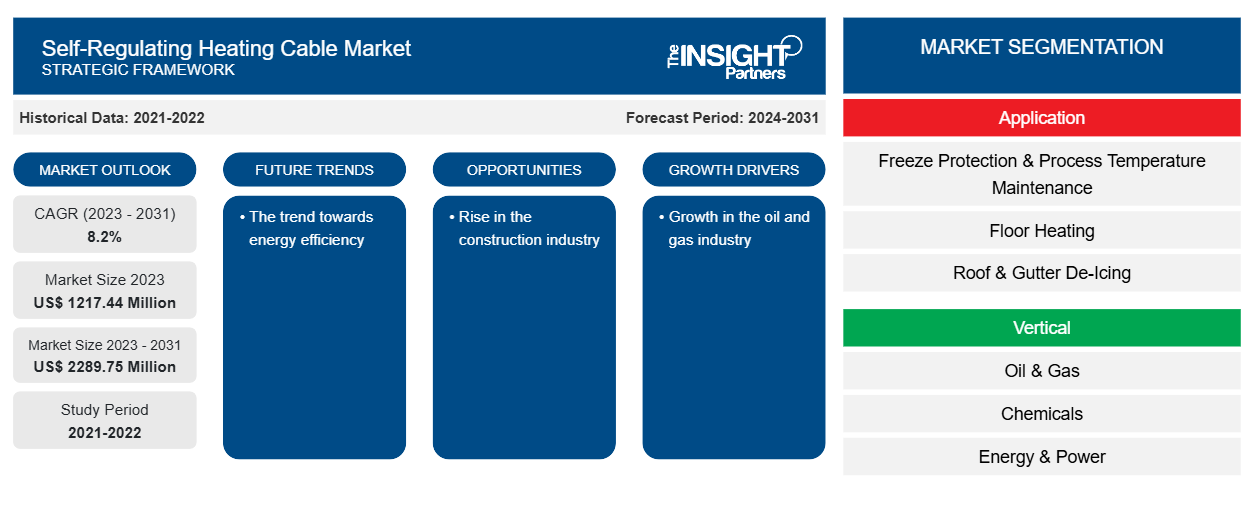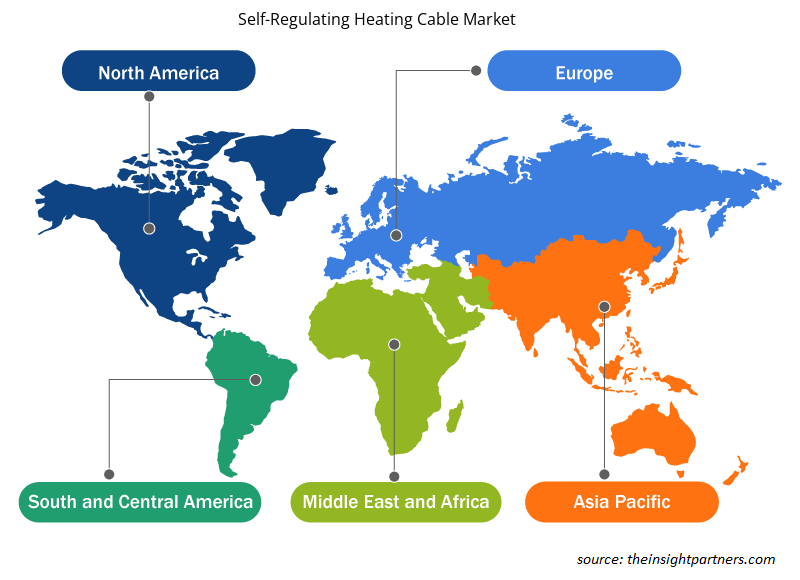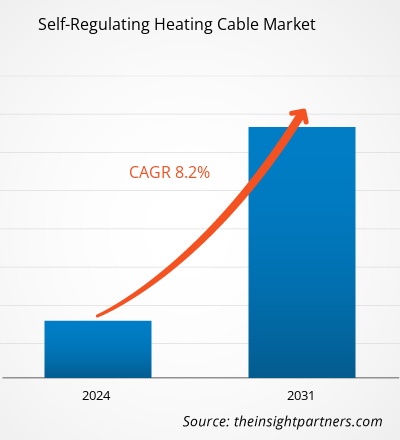The self-regulating heating cable market size is projected to reach US$ 2289.75 million by 2031 from US$ 1217.44 million in 2023. The market is expected to register a CAGR of 8.2% in 2023–2031. The growing oil and gas industry and soaring demand from the construction sector are likely to remain key to self-regulating heating cable market trends.
Self-Regulating Heating Cable Market Analysis
The benefits of using self-regulating heating cables include ease, safe, and energy efficiency, leading to their adoption across several industries. It automatically adjusts its heat output to compensate for changes in ambient temperature, ensuring that heat is produced only when and where it is required. Owing to its benefits, it is widely adopted in the oil and gas projects and construction industry.
Self-Regulating Heating Cable Market Overview
Self-regulating heating cables are also referred to as self-limiting heating cables. In a self-regulating heating cable, heat is produced as electric current flows through the conductive polymer core between the cable's conductors. The number of electrical paths through the core increases, producing more heat as the ambient temperature drops. In contrast, as the temperature rises, the core has fewer electrical paths and produces less heat. Self-regulating heating cables can be used to prevent pipes from freezing, keep liquids at the proper temperature, heat tanks, melt snow on roofs and surfaces, give instant hot water at the tap, and even heat floors.
Customize This Report To Suit Your Requirement
You will get customization on any report - free of charge - including parts of this report, or country-level analysis, Excel Data pack, as well as avail great offers and discounts for start-ups & universities
Self-Regulating Heating Cable Market: Strategic Insights

- Get Top Key Market Trends of this report.This FREE sample will include data analysis, ranging from market trends to estimates and forecasts.
You will get customization on any report - free of charge - including parts of this report, or country-level analysis, Excel Data pack, as well as avail great offers and discounts for start-ups & universities
Self-Regulating Heating Cable Market: Strategic Insights

- Get Top Key Market Trends of this report.This FREE sample will include data analysis, ranging from market trends to estimates and forecasts.
Self-Regulating Heating Cable Market Drivers and Opportunities
Growth in the oil and gas industry to Favor Market
The oil & gas industry has played a significant role in this industrial revolution and the economic transformation of the world. The major factor driving the evolution of this industry is the growing demand for heat, mobility, and light worldwide, owing to the rapidly growing population. The oil & gas industry accounted for the largest share of global consumption of energy resources. Per the International Energy Agency (IEA), the worldwide oil demand will rise by 6% between 2022 and 2028 to reach 105.7 million barrels per day with the rise in demand from various industries. Thus, the growth in the oil and gas industry leads to increased demand for pipelines and facilities where self-regulating heating cables can be used.
Rise in the construction industry market
Urbanization and rising increased disposable income of the people are some of the major factors fueling the residential and commercial infrastructure. As the number of commercial buildings grows at an unprecedented rate, self-regulating heating cables are increasingly used in the construction industry to protect pipes from freezing and to keep equipment at the proper temperature. Global population growth drives the construction industry forward. Companies in the global self-regulating heating cables market are focusing on partnerships to make their products available in both developing and developed countries.
Self-Regulating Heating Cable Market Report Segmentation Analysis
Key segments that contributed to the derivation of the self-regulating heating cable market analysis are application and vertical.
- By application, the market is segmented into freeze protection & process temperature maintenance, floor heating, roof & gutter de-icing, and others.
- Based on the vertical, the market is segmented into oil & gas, chemicals, energy & power, commercial, residential, and others. The oil & gas segment held a larger market share in 2023.
Self-Regulating Heating Cable Market Share Analysis by Geography
The geographic scope of the self-regulating heating cable market report is mainly divided into five regions: North America, Asia Pacific, Europe, Middle East & Africa, and South America/South & Central America.
In terms of revenue, Asia Pacific accounted for the largest self-regulating heating cable market share in 2023. The presence of a large number of self-regulating heating cable manufacturers in the region leads to the region’s market growth. The surge in the oil and gas industry in the region is driving the use of self-regulating heating cables. The rise in the construction industry leads to the growing demand for self-regulating heating cables.
Self-Regulating Heating Cable Market Regional Insights
The regional trends and factors influencing the Self-Regulating Heating Cable Market throughout the forecast period have been thoroughly explained by the analysts at The Insight Partners. This section also discusses Self-Regulating Heating Cable Market segments and geography across North America, Europe, Asia Pacific, Middle East and Africa, and South and Central America.

- Get the Regional Specific Data for Self-Regulating Heating Cable Market
Self-Regulating Heating Cable Market Report Scope
| Report Attribute | Details |
|---|---|
| Market size in 2023 | US$ 1217.44 Million |
| Market Size by 2031 | US$ 2289.75 Million |
| Global CAGR (2023 - 2031) | 8.2% |
| Historical Data | 2021-2022 |
| Forecast period | 2024-2031 |
| Segments Covered |
By Application
|
| Regions and Countries Covered | North America
|
| Market leaders and key company profiles |
Self-Regulating Heating Cable Market Players Density: Understanding Its Impact on Business Dynamics
The Self-Regulating Heating Cable Market is growing rapidly, driven by increasing end-user demand due to factors such as evolving consumer preferences, technological advancements, and greater awareness of the product's benefits. As demand rises, businesses are expanding their offerings, innovating to meet consumer needs, and capitalizing on emerging trends, which further fuels market growth.
Market players density refers to the distribution of firms or companies operating within a particular market or industry. It indicates how many competitors (market players) are present in a given market space relative to its size or total market value.
Major Companies operating in the Self-Regulating Heating Cable Market are:
- BARTEC Top Holding GmbH
- Danfoss A/S
- eltherm GmbH
- Emerson Electric Co.
- Heat Trace Limited
- NEXANS
Disclaimer: The companies listed above are not ranked in any particular order.

- Get the Self-Regulating Heating Cable Market top key players overview
Self-Regulating Heating Cable Market News and Recent Developments
The Self-Regulating Heating Cable Marketis evaluated by gathering qualitative and quantitative data post primary and secondary research, which includes important corporate publications, association data, and databases. The following is a list of developments in the market:
- In June 2023, nVent Electric plc, a global leader in electrical connection and protection solutions, launched its newest self-regulating heating cable, the nVent RAYCHEM XTVR. Building on the proven benefits of the nVent RAYCHEM XTV heating cable, the XTVR heating cables deliver reliable and efficient performance in higher temperatures and come with more power variants. Designed for use in freeze protection and process temperature maintenance applications, XVR heating cables have a minimum of 95% power retention after 10 years and a design life of 30 years or more. (Source: nVent Electric plc, Press Release, 2023)
Self-Regulating Heating Cable Market Report Coverage and Deliverables
The “Self-Regulating Heating Cable Market Size and Forecast (2021–2031)” report provides a detailed analysis of the market covering below areas:
- Market size and forecast at global, regional, and country levels for all the key market segments covered under the scope
- Market dynamics such as drivers, restraints, and key opportunities
- Key future trends
- Detailed PEST/Porter’s Five Forces and SWOT analysis
- Global and regional market analysis covering key market trends, major players, regulations, and recent market developments
- Industry landscape and competition analysis covering market concentration, heat map analysis, prominent players, and recent developments
- Detailed company profiles
Frequently Asked Questions
What is the estimated market size for the global self-regulating heating cable market in 2023?
The global self-regulating heating cable market was estimated to be US$ 1217.44 million in 2023 and is expected to grow at a CAGR of 8.2% during the forecast period 2023 - 2031.
What are the driving factors impacting the global self-regulating heating cable market?
The growing oil and gas industry and soaring demand from the construction sector are the major factors that propel the global self-regulating heating cable market.
What are the future trends of the global self-regulating heating cable market?
The trend towards energy efficiency is anticipated to play a significant role in the global self-regulating heating cable market in the coming years.
Which are the key players holding the major market share of the global self-regulating heating cable market?
The key players holding majority shares in the global self-regulating heating cable market are BARTEC Top Holding GmbH, Danfoss A/S, eltherm GmbH, Emerson Electric Co., and nVent Electric plc.
What will be the market size of the global self-regulating heating cable market by 2031?
The global self-regulating heating cable market is expected to reach US$ 2289.75 million by 2031.
What is the incremental growth of the global self-regulating heating cable market during the forecast period?
The incremental growth expected to be recorded for the global self-regulating heating cable market during the forecast period is US$ 1072.31 million.
- Historical Analysis (2 Years), Base Year, Forecast (7 Years) with CAGR
- PEST and SWOT Analysis
- Market Size Value / Volume - Global, Regional, Country
- Industry and Competitive Landscape
- Excel Dataset
Testimonials
Reason to Buy
- Informed Decision-Making
- Understanding Market Dynamics
- Competitive Analysis
- Identifying Emerging Markets
- Customer Insights
- Market Forecasts
- Risk Mitigation
- Boosting Operational Efficiency
- Strategic Planning
- Investment Justification
- Tracking Industry Innovations
- Aligning with Regulatory Trends
Yes! We provide a free sample of the report, which includes Report Scope (Table of Contents), report structure, and selected insights to help you assess the value of the full report. Please click on the "Download Sample" button or contact us to receive your copy.
Absolutely — analyst assistance is part of the package. You can connect with our analyst post-purchase to clarify report insights, methodology or discuss how the findings apply to your business needs.
Once your order is successfully placed, you will receive a confirmation email along with your invoice.
• For published reports: You’ll receive access to the report within 4–6 working hours via a secured email sent to your email.
• For upcoming reports: Your order will be recorded as a pre-booking. Our team will share the estimated release date and keep you informed of any updates. As soon as the report is published, it will be delivered to your registered email.
We offer customization options to align the report with your specific objectives. Whether you need deeper insights into a particular region, industry segment, competitor analysis, or data cut, our research team can tailor the report accordingly. Please share your requirements with us, and we’ll be happy to provide a customized proposal or scope.
The report is available in either PDF format or as an Excel dataset, depending on the license you choose.
The PDF version provides the full analysis and visuals in a ready-to-read format. The Excel dataset includes all underlying data tables for easy manipulation and further analysis.
Please review the license options at checkout or contact us to confirm which formats are included with your purchase.
Our payment process is fully secure and PCI-DSS compliant.
We use trusted and encrypted payment gateways to ensure that all transactions are protected with industry-standard SSL encryption. Your payment details are never stored on our servers and are handled securely by certified third-party processors.
You can make your purchase with confidence, knowing your personal and financial information is safe with us.
Yes, we do offer special pricing for bulk purchases.
If you're interested in purchasing multiple reports, we’re happy to provide a customized bundle offer or volume-based discount tailored to your needs. Please contact our sales team with the list of reports you’re considering, and we’ll share a personalized quote.
Yes, absolutely.
Our team is available to help you make an informed decision. Whether you have questions about the report’s scope, methodology, customization options, or which license suits you best, we’re here to assist. Please reach out to us at sales@theinsightpartners.com, and one of our representatives will get in touch promptly.
Yes, a billing invoice will be automatically generated and sent to your registered email upon successful completion of your purchase.
If you need the invoice in a specific format or require additional details (such as company name, GST, or VAT information), feel free to contact us, and we’ll be happy to assist.
Yes, certainly.
If you encounter any difficulties accessing or receiving your report, our support team is ready to assist you. Simply reach out to us via email or live chat with your order information, and we’ll ensure the issue is resolved quickly so you can access your report without interruption.





















 Get Free Sample For
Get Free Sample For